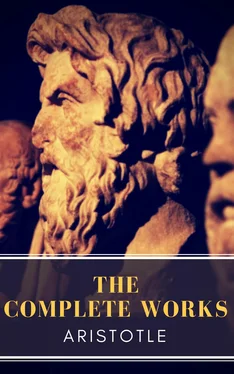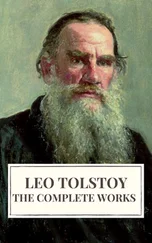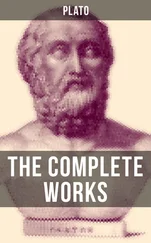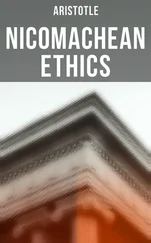Aristotle Aristotle - Aristotle - The Complete Works
Здесь есть возможность читать онлайн «Aristotle Aristotle - Aristotle - The Complete Works» — ознакомительный отрывок электронной книги совершенно бесплатно, а после прочтения отрывка купить полную версию. В некоторых случаях можно слушать аудио, скачать через торрент в формате fb2 и присутствует краткое содержание. Жанр: unrecognised, на английском языке. Описание произведения, (предисловие) а так же отзывы посетителей доступны на портале библиотеки ЛибКат.
- Название:Aristotle: The Complete Works
- Автор:
- Жанр:
- Год:неизвестен
- ISBN:нет данных
- Рейтинг книги:3 / 5. Голосов: 1
-
Избранное:Добавить в избранное
- Отзывы:
-
Ваша оценка:
- 60
- 1
- 2
- 3
- 4
- 5
Aristotle: The Complete Works: краткое содержание, описание и аннотация
Предлагаем к чтению аннотацию, описание, краткое содержание или предисловие (зависит от того, что написал сам автор книги «Aristotle: The Complete Works»). Если вы не нашли необходимую информацию о книге — напишите в комментариях, мы постараемся отыскать её.
This edition has been professionally formatted and contains several tables of contents. The first table of contents (at the very beginning of the ebook) lists the titles of all novels included in this volume. By clicking on one of those titles you will be redirected to the beginning of that work, where you'll find a new TOC that lists all the chapters and sub-chapters of that specific work.
Aristotle: The Complete Works — читать онлайн ознакомительный отрывок
Ниже представлен текст книги, разбитый по страницам. Система сохранения места последней прочитанной страницы, позволяет с удобством читать онлайн бесплатно книгу «Aristotle: The Complete Works», без необходимости каждый раз заново искать на чём Вы остановились. Поставьте закладку, и сможете в любой момент перейти на страницу, на которой закончили чтение.
Интервал:
Закладка:
Again, it may be shown in the following way that there can be no motion of a point or of any other indivisible. That which is in motion can never traverse a space greater than itself without first traversing a space equal to or less than itself. That being so, it is evident that the point also must first traverse a space equal to or less than itself. But since it is indivisible, there can be no space less than itself for it to traverse first: so it will have to traverse a distance equal to itself. Thus the line will be composed of points, for the point, as it continually traverses a distance equal to itself, will be a measure of the whole line. But since this is impossible, it is likewise impossible for the indivisible to be in motion.
Again, since motion is always in a period of time and never in a moment, and all time is divisible, for everything that is in motion there must be a time less than that in which it traverses a distance as great as itself. For that in which it is in motion will be a time, because all motion is in a period of time; and all time has been shown above to be divisible. Therefore, if a point is in motion, there must be a time less than that in which it has itself traversed any distance. But this is impossible, for in less time it must traverse less distance, and thus the indivisible will be divisible into something less than itself, just as the time is so divisible: the fact being that the only condition under which that which is without parts and indivisible could be in motion would have been the possibility of the infinitely small being in motion in a moment: for in the two questions-that of motion in a moment and that of motion of something indivisible-the same principle is involved.
Our next point is that no process of change is infinite: for every change, whether between contradictories or between contraries, is a change from something to something. Thus in contradictory changes the positive or the negative, as the case may be, is the limit, e.g. being is the limit of coming to be and not-being is the limit of ceasing to be: and in contrary changes the particular contraries are the limits, since these are the extreme points of any such process of change, and consequently of every process of alteration: for alteration is always dependent upon some contraries. Similarly contraries are the extreme points of processes of increase and decrease: the limit of increase is to be found in the complete magnitude proper to the peculiar nature of the thing that is increasing, while the limit of decrease is the complete loss of such magnitude. Locomotion, it is true, we cannot show to be finite in this way, since it is not always between contraries. But since that which cannot be cut (in the sense that it is inconceivable that it should be cut, the term ‘cannot’ being used in several senses)-since it is inconceivable that that which in this sense cannot be cut should be in process of being cut, and generally that that which cannot come to be should be in process of coming to be, it follows that it is inconceivable that that which cannot complete a change should be in process of changing to that to which it cannot complete a change. If, then, it is to be assumed that that which is in locomotion is in process of changing, it must be capable of completing the change. Consequently its motion is not infinite, and it will not be in locomotion over an infinite distance, for it cannot traverse such a distance.
It is evident, then, that a process of change cannot be infinite in the sense that it is not defined by limits. But it remains to be considered whether it is possible in the sense that one and the same process of change may be infinite in respect of the time which it occupies. If it is not one process, it would seem that there is nothing to prevent its being infinite in this sense; e.g. if a process of locomotion be succeeded by a process of alteration and that by a process of increase and that again by a process of coming to be: in this way there may be motion for ever so far as the time is concerned, but it will not be one motion, because all these motions do not compose one. If it is to be one process, no motion can be infinite in respect of the time that it occupies, with the single exception of rotatory locomotion.
Physics, Book VII
Translated by R. P. Hardie and R. K. Gaye
<
div id="section57" class="section" title="1">
1
Everything that is in motion must be moved by something. For if it has not the source of its motion in itself it is evident that it is moved by something other than itself, for there must be something else that moves it. If on the other hand it has the source of its motion in itself, let AB be taken to represent that which is in motion essentially of itself and not in virtue of the fact that something belonging to it is in motion. Now in the first place to assume that AB, because it is in motion as a whole and is not moved by anything external to itself, is therefore moved by itself-this is just as if, supposing that KL is moving LM and is also itself in motion, we were to deny that KM is moved by anything on the ground that it is not evident which is the part that is moving it and which the part that is moved. In the second place that which is in motion without being moved by anything does not necessarily cease from its motion because something else is at rest, but a thing must be moved by something if the fact of something else having ceased from its motion causes it to be at rest. Thus, if this is accepted, everything that is in motion must be moved by something. For AB, which has been taken to represent that which is in motion, must be divisible since everything that is in motion is divisible. Let it be divided, then, at G. Now if GB is not in motion, then AB will not be in motion: for if it is, it is clear that AG would be in motion while BG is at rest, and thus AB cannot be in motion essentially and primarily. But ex hypothesi AB is in motion essentially and primarily. Therefore if GB is not in motion AB will be at rest. But we have agreed that that which is at rest if something else is not in motion must be moved by something. Consequently, everything that is in motion must be moved by something: for that which is in motion will always be divisible, and if a part of it is not in motion the whole must be at rest.
Since everything that is in motion must be moved by something, let us take the case in which a thing is in locomotion and is moved by something that is itself in motion, and that again is moved by something else that is in motion, and that by something else, and so on continually: then the series cannot go on to infinity, but there must be some first movent. For let us suppose that this is not so and take the series to be infinite. Let A then be moved by B, B by G, G by D, and so on, each member of the series being moved by that which comes next to it. Then since ex hypothesi the movent while causing motion is also itself in motion, and the motion of the moved and the motion of the movent must proceed simultaneously (for the movent is causing motion and the moved is being moved simultaneously) it is evident that the respective motions of A, B, G, and each of the other moved movents are simultaneous. Let us take the motion of each separately and let E be the motion of A, Z of B, and H and O respectively the motions of G and D: for though they are all moved severally one by another, yet we may still take the motion of each as numerically one, since every motion is from something to something and is not infinite in respect of its extreme points. By a motion that is numerically one I mean a motion that proceeds from something numerically one and the same to something numerically one and the same in a period of time numerically one and the same: for a motion may be the same generically, specifically, or numerically: it is generically the same if it belongs to the same category, e.g. substance or quality: it is specifically the same if it proceeds from something specifically the same to something specifically the same, e.g. from white to black or from good to bad, which is not of a kind specifically distinct: it is numerically the same if it proceeds from something numerically one to something numerically one in the same period of time, e.g. from a particular white to a particular black, or from a particular place to a particular place, in a particular period of time: for if the period of time were not one and the same, the motion would no longer be numerically one though it would still be specifically one.
Читать дальшеИнтервал:
Закладка:
Похожие книги на «Aristotle: The Complete Works»
Представляем Вашему вниманию похожие книги на «Aristotle: The Complete Works» списком для выбора. Мы отобрали схожую по названию и смыслу литературу в надежде предоставить читателям больше вариантов отыскать новые, интересные, ещё непрочитанные произведения.
Обсуждение, отзывы о книге «Aristotle: The Complete Works» и просто собственные мнения читателей. Оставьте ваши комментарии, напишите, что Вы думаете о произведении, его смысле или главных героях. Укажите что конкретно понравилось, а что нет, и почему Вы так считаете.












